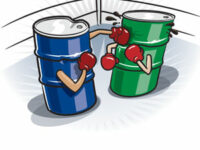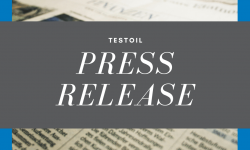Not exactly sure what oil is in the reservoir, but it’s running low and probably OK to top it off with whatever’s around, right? Wrong—but not always. So how do you know which lubricants are compatible and which are, well, like oil and water? There are really only two ways:
1. Ask one or both of the manufacturers
2. Test the lubricants for compatibility
Eurofins TestOil Analytical Services Manager Monika Malcolm explains, “We would recommend compatibility testing in cases where oils will be intentionally mixed in machines. Reasons this could occur include: the plant is trying to consolidate lubricants in use; the current product is discontinued; there are supply chain issues, etc.”
Eurofins TestOil’s Compatibility Studies are based on ASTM D7155-20 Evaluating Compatibility of Mixtures of Turbine Lubricating Oils. The method has four tiers of testing. Tier I Visual Appearance and Tier II Interfacial Properties are required. Tier III and Tier IV are considered optional, but can provide information regarding other critical properties of the lubricant.
- Tier I calls for heating the mixtures along with neat samples of the constituent oils for a period of time, then incubating at room temperature, with visual assessments of the mixtures for clarity and development of precipitates after both the heating and room temperature incubation.
- Tier II includes tests such as ASTM D1401 to determine water separability, ASTM D892 to determine foaming characteristics, and ASTM D7843 to check for development of insolubles.
- Tier III tests are considered Physical and Chemical Property tests (for example ASTM D445 viscosity or ASTM D5185 additive metals).
- Tier IV tests are considered Specific Performance Property tests (such as ASTM D665 Rust, ASTM D130 Copper Corrosion, or ASTM D2272 RPVOT).
Compatibility testing will identify incompatible lubricants before they are mixed in equipment and cause operational issues. Alternative choices can then be evaluated so that a suitable replacement can be selected.
According to Monika, lubricants usually get mixed in one of three ways: due to the intentional addition of a different lubricant to a machine; accidental addition of the wrong lubricant to the machine; or due to accidental contamination with a different lubricant, i.e. a leaking hydraulic line dripping hydraulic fluid onto a gearbox resulting in the hydraulic fluid entering the oil system of the gearbox.
Accidental addition of the wrong lubricant can largely be prevented through the use of a visual management system (color/shape codes for each type of lubricant in use in the plant, cards/stickers attached to each machine and each lube in the lube room) to identify the product in use for each machine.
Monika adds, “In cases where the lubricant that has been in use is either temporarily or permanently no longer available, then performing a compatibility study to ensure the lubricants are compatible before mixing them in equipment can help avoid downtime due to adverse effects from mixing lubricants.”
There are consequences—often serious--for mixing incompatible fluids. “Mixing incompatible lubricants can result in loss of critical performance characteristics of the lubricant (such as the ability to separate from air, the ability to separate from water, loss of rust/corrosion protection, etc.),” Monika says. “Mixing incompatible lubricants can also result in drop out of additives and/or formation of insoluble materials which can clog filters and interfere with the functioning of moving parts.”
All of this can be avoided with a little due diligence and testing, if necessary. “With testing, incompatible lubricants can be identified before they are mixed in equipment and cause operational issues. Alternative choices can be evaluated so that a suitable replacement can be selected,” Monika concludes.
For more information on working with Eurofins TestOil for oil analysis and training visit www.testoil.com. Contact: 216-251-2510; sales@testoil.com.
With more than 30 years of experience in the oil analysis industry, Eurofins TestOil, focuses exclusively on assisting industrial facilities with reducing maintenance costs and avoiding unexpected downtime through oil analysis program implementation. As industry experts in diagnosing oil-related issues in equipment such as turbines, hydraulics, gearboxes, pumps, compressors and diesel generators, Eurofins TestOil provides customers with a guarantee of same-day turnaround on all routine testing. Eurofins TestOil PRO certified lubrication professionals educate the industry on oil analysis through public and private onsite training. These highly experienced professionals provide a variety of onsite services; from collecting oil samples to conducting failure analyses to writing work orders. For more information on partnering with Eurofins TestOil on oil analysis programs or training opportunities visit https://testoil.com. Contact: Michael Barrett 216-251-2510; sales@testoil.com.




